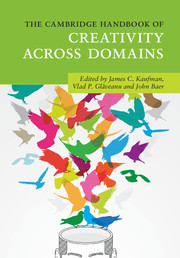Book contents
- The Cambridge Handbook of Creativity Across Domains
- The Cambridge Handbook of Creativity Across Domains
- Copyright page
- Dedication
- Contents
- Figures
- Tables
- Contributors
- Acknowledgments
- Part I Creativity and Domain
- Part II Creativity in the Traditional Arts
- Part III Creativity in the Sciences
- Part IV Creativity in Business
- Part V Newer Domains for Creativity Research
- Part VI Creativity in Everyday Life
- 29 Creativity in the Domain of Emotions
- 30 Creativity in Teaching
- 31 Culture and Creativity
- 32 The Benefits of Creativity in Therapy
- 33 Creativity in the Domain of Play
- 34 Creativity in Craft
- Part VII Conclusion
- Index
- References
31 - Culture and Creativity
from Part VI - Creativity in Everyday Life
Published online by Cambridge University Press: 15 September 2017
- The Cambridge Handbook of Creativity Across Domains
- The Cambridge Handbook of Creativity Across Domains
- Copyright page
- Dedication
- Contents
- Figures
- Tables
- Contributors
- Acknowledgments
- Part I Creativity and Domain
- Part II Creativity in the Traditional Arts
- Part III Creativity in the Sciences
- Part IV Creativity in Business
- Part V Newer Domains for Creativity Research
- Part VI Creativity in Everyday Life
- 29 Creativity in the Domain of Emotions
- 30 Creativity in Teaching
- 31 Culture and Creativity
- 32 The Benefits of Creativity in Therapy
- 33 Creativity in the Domain of Play
- 34 Creativity in Craft
- Part VII Conclusion
- Index
- References
Summary
We present research on creativity in the culture domain through the lens of four broad guiding questions: unique features, constructs and measurements, empirical findings, and future directions. Regarding unique features, we note that (a) creativity and culture are naturally intertwined concepts and it is difficult to imagine one without the other; (b) the meaning of creativity may differ across cultures; (c) creativity and culture can be studied taking a broad variety of theoretical perspectives; and (d) culture does not exist in isolation, so it is essential to consider the role of multiculturalism on creativity. Regarding constructs and measurements, we describe both historiometric and psychometric methodological approaches. Historiometric approaches have mainly focused on creative products and have explored the link between culture and creativity both at the aggregate and individual level, whereas psychometric approaches have focused on the creative product, person, and process, conducting both correlational and experimental studies. We introduce the most common constructs and measurements from each methodological approach. The empirical findings section is structured based on two broad research questions that are typical of creativity in the culture domain: (a) Does creativity differ across cultures (especially across East vs. West), and (b) How does multiculturalism affect creativity? Findings pertaining to each of these two sections are further differentiated based on the methodology employed (historiometric vs. psychometric). In the last section of the chapter, we discuss future directions relevant to each of the different streams of research traditions.
- Type
- Chapter
- Information
- The Cambridge Handbook of Creativity across Domains , pp. 565 - 586Publisher: Cambridge University PressPrint publication year: 2017
References
- 1
- Cited by



